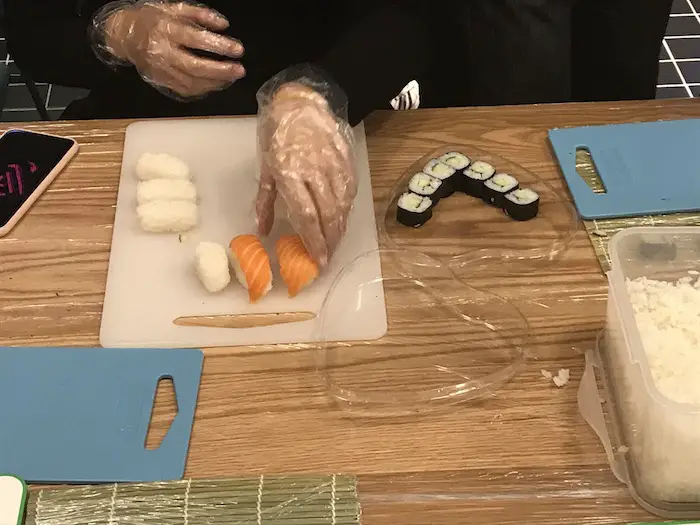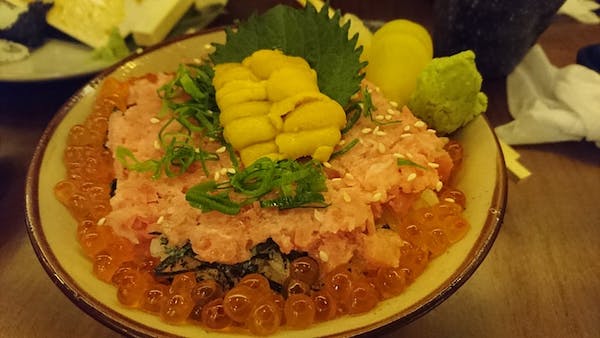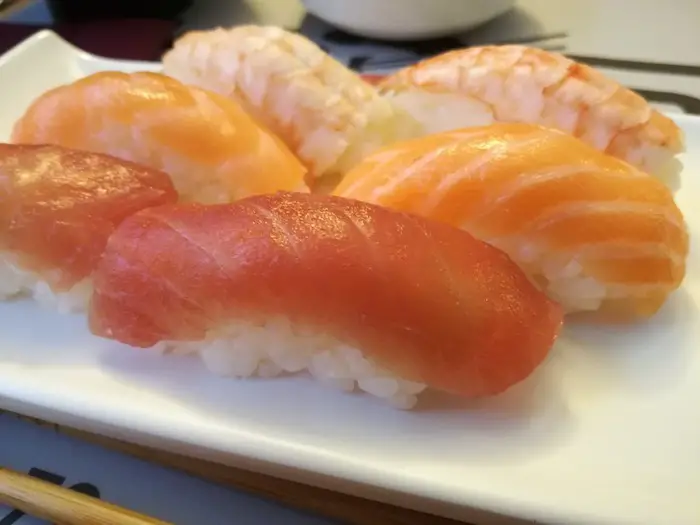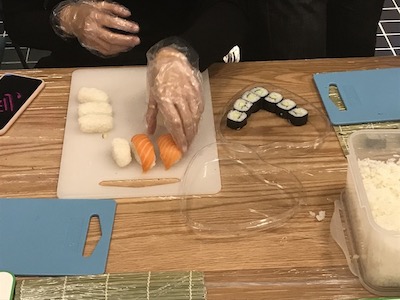We are reader supported. When you purchase through links on our site, we may earn an affiliate commission. Also, as an Amazon affiliate, we earn from qualifying purchases.

Sushi is the first thing that comes to my mind when I hear Japanese cuisine. No wonder they have varied foods, but perhaps no other dish has gained so much popularity and acceptance worldwide. Today, you can find sushi restaurants around the world and people of different cultures have fun making sushi at home.
Do the Japanese make sushi at home? With sushi eateries located in almost every corner of the country, it’s natural to wonder whether or not they actually make sushi at home. The answer is ‘yes’. While the most exotic varieties like nigiri are best left to the experts who have over 10 years of experience, the Japanese occasionally make chirashi and maki rolls at home.
In a typical Japanese kitchen, you will always find the various ingredients required to prepare a sushi meal. Those who are enthusiastic about preparing their own meals at home may even have plastic sushi mold to be able to roll out sushi with ease. Most of these sushi molds and kits are made in Japan. You can check out my article about the best sushi kits for beginners.
Contents
Japanese Housewives’ Skills At Making Sushi
For an outsider, it may seem obvious for any Japanese housewife to be proficient at making sushi at home. While it’s true that sushi is a frequently made dish at home, it’s not always prepared in the way you envision them.
Unlike the restaurant-style nigiri, those who are passionate about cooking may try their hand at making kanypo-maki, inari sushi, temari sushi, and a bowl of chirashi. Let’s take a quick look at what these dishes comprise of:
Kanypo Maki-zushi: This is traditional comfort food in Japan that contains the cooked dried shavings of the gourd. It is known as children’s favorite and housewives may often make it for school or office lunch. They are also made for picnics.

Chirashi bowl: Also known as chirashizushi, this style of sushi contains a mix of various ingredients such as boiled shrimp, sliced fried egg, cooked shiitake, sliced tuna, cooked kanpyo, cooked carrot, spread over seasoned sushi rice. I have created an article that contains the recipe for chirashizushi, check it out here.

Inari-zushi: This is a special type of sushi that does not contain any extra fillings except sushi rice. The rice is stuffed inside a cooked abura-agé, often referred to as deep-fried bean curd. Japanese women like making this dish for sports days, picnics, and school lunch. Read my article that explains how to make inarizushi at home.
Tekka-don (Tuna bowl): This is another simplistic sushi similar to chirashi in preparation. It basically comprises of sashimi slices (mostly tuna) marinated well with shoyu and arranged over seasoned sushi rice. It requires no rolling or cutting skills, hence anyone can make it at home with ease.

Nigirizushi or nigiri sushi requires a higher set of skills to be able to cut a thin slice of raw fish and blend it with rice so that they stay together but melt into your mouth. The Japanese do not dare mess with the nigiri, hence leave it to the master chefs to create the perfect pieces.
In Japan, sushi chefs are highly revered because they spend over 10 years of extensive learning and practicing the art of making sushi. They usually prefer dining out if they are in the mood for nigirizushi or different types of specialty rolls.
Myths Involving Sushi In Japan
One of the most common myths is that Japanese people eat sushi often and probably make them every day at home. This is far from the truth. Japan has its share of passionate sushi enthusiasts who like to eat sushi often but it’s not their everyday meal.
The Japanese cuisine is highly varied and there many other delicious dishes other than sushi, although they are not as popular worldwide. Interesting, the local Japanese also find high end sushi-ya intimidating, just like foreigners do.
The locals would like to give these traditional places a miss and dine at a more casual eatery on the street side. Most of them are busy professionals who prefer to grab a quick sushi lunch from a supermarket or convenience store. So, making full-blown sushi at home or dining at a typical high-end sushi restaurant is for special occasions.
Sushi Sold At Supermarkets And Convenience Stores In Japan
Another important reason why Japanese don’t bother much about making sushi at home is that they are readily available at convenience stores and supermarkets across the country. Making sushi is a time taking process and most of the time is spent in cooking rice and preparing the fish or vegetable fillings.
Some people may wonder whether the supermarket or store bought sushi is good or fresh enough to eat. To that, my answer is ‘yes’. The Japanese are very particular about the sushi quality sold at stores and they take due measures to ensure that they have the finest quality on the shelves.
Contrary to what people may think, there is usually no sushi chef at the back of the counter making fresh sushi for you. They are mostly prepared at a different facility and then shipped in a van with controlled temperature to the stores across the city
Optimum temperature is maintained to ensure that raw fish in sushi does not go bad. In some stores, there may be a sushi chef who arrives at a specific time to prepare a bulk amount of sushi that is then displayed on the shelves.
The only issue with supermarket sushi is that the quality tends to go down with time. They are typically chilled at a temperature between 3°C and 6°C during transit as well as while they sit on the shelves for display. If the sushi sits in such a cold temperature for too long, the rice tends to get dry and loses its authentic flavor.
Where To Look For Sushi In Japan
If you are desperately seeking good sushi in Japan and do not have the time to sit down and eat, you can get them from the local supermarket. As the Japanese prefer picking their sushi lunch from the stores, there’s a huge demand for them.
Most of the sushi in local stores are fresh and good quality as they are sold out as soon as they arrive. If at all, a store has sushi that have been sitting out for quite some time, they will immediately reduce the price and put them separately on a shelf. After a certain point, the unsold sushi are taken off the shelves entirely.
The Way Sushi Is Eaten In Japan
They say that if you are visiting a country, eat and drink like the locals to understand their culture. I can’t agree more. When you are eating nigiri sushi in a restaurant in Japan, dump the chopsticks and pick it up with your hands.
While everyone at Japan knows how to use chopsticks, you will not be laughed at if you are a non-Japanese not knowing how to eat with it. Use your hands instead because it’s better to avoid something you are not good at than doing it the wrong way.
I have created an article that talks about sushi etiquettes you must follow in a restaurant to ensure that you do not offend the chef or fellow diners.
5 Popular Sushi In Japan
In western countries, we are more used to the Americanized version of sushi slathered in sauces, creams, and other condiments. The traditional sushi in Japan is more humble and sometimes the style of preparation may be surprisingly different from what we are used to. Here are some of the lesser-known sushi that are extremely popular in Japan:
#1. Chakin Sushi
Also known as Chakinzushi, this style of sushi comprises of small balls of seasoned sushi rice wrapped in a delicate egg crepe. The wrapping is often pulled upwards to give it an appearance of a cute bag that is tied with string. The rectangular shaped bags are called fukusazushi.
#2. Kakinoha Sushi
Kakinohazushi of Kakinoha Sushi is a specialty of Nara, Kansai region. It can be translated in English to mean ‘persimmon leaf sushi’. In this type of sushi, the seasoned rice and fish toppings are pressed gently to form a rectangular mold. It Is then cut into equal bite-size pieces using a sharp knife and the pieces are wrapped in a persimmon leaf.
#3. Oshi Sushi (Oshizushi)
This is a regional specialty you can find at the Kansai and Osaka region. In this type, the sushi is prepared by layering a mold with seasoned rice and cooked toppings to blend them into an even shape. The sushi is then cut into equal smaller sizes, which are then known as box sushi or hako sushi.
#4. Temari Sushi

Also referred to as Temarizushi, the Temari Sushi is yet another form of nigirizushi, a casual style of the dish prepared by pressing the seasoned rice into a ball shape. They are attractive to look at and Japanese like to make them at home on special occasions like Halloween, Christmas, Hinamatsuri, and picnics. The cute balls can be decorated as per the holiday theme.
#5. Nare Sushi
Also known as Narezushi, this is a forerunner of contemporary sushi and you can still find them in different regions across Japan. They are popular as a local specialty called funazushi in Shiga Prefecture. This dish primarily consists of raw fish that is pickled in rice and salt.
The fish and rice used in funazushi are often fermented for years. It is almost similar to how the ancestors preserved fish in rice. They may serve a little portion of the rice with fish. It is one of the most unique variations in terms of taste, looks, and texture of the sushi.
Related Questions
What type of sushi do the Japanese like best?
When it comes to sushi, medium-fatty tuna or chotoro sushi walks away with the winning title. It is closely followed by salmon sushi and red tuna secures its position as the third best.
Is Japanese sushi different from what you see in western countries?
In Japan, you will mostly find sashimi slices over a rice bed and this style is known as nigirizushi. Sushi rolls look different as they are surprisingly simpler with just a white circle of rice tightly holding raw fish or cucumber within and Nori on the outside. For more: Difference Between Japanese Sushi And American Sushi
Is sushi expensive in Japan?
A sushi meal at an average restaurant may cost you between 1000 and 3000 yen($30 USD), and the high-end restaurants may cost even more. In the rush hours during lunch, some restaurants may offer cheaper teishoku at about 1000 yen ($10 USD).


